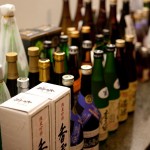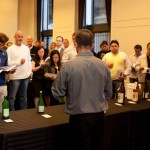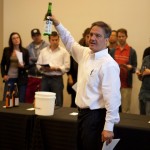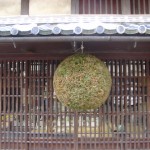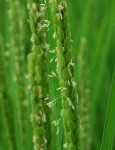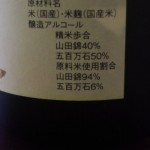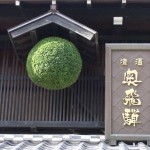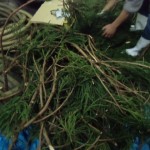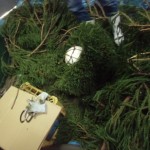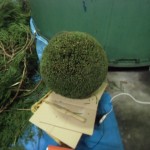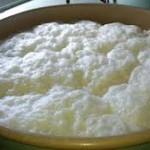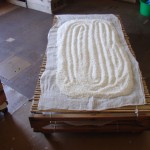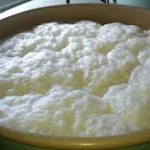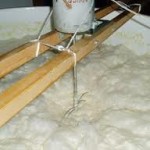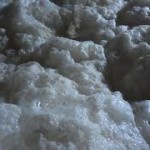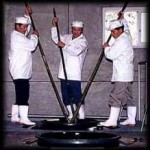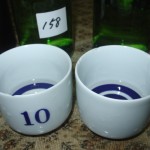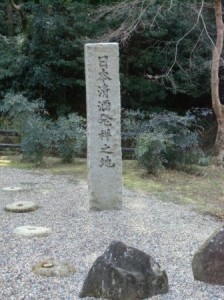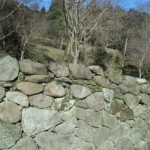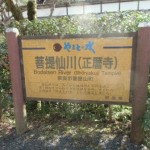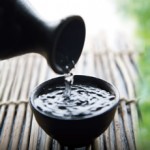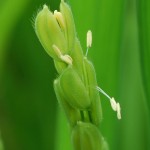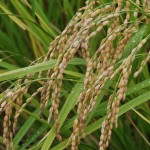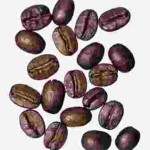It was well into the evening when the phone rang, but my caller i.d. told me the call was 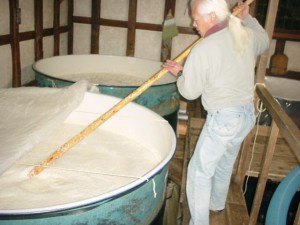 from a brewer in Akita Prefecture. Since he fits into both the friend and business associate categories, I picked it up.
from a brewer in Akita Prefecture. Since he fits into both the friend and business associate categories, I picked it up.
“Du-hu-hu-hu-de. I’m pretty ha-a-a-a-mmered.” Not your typical call from the owner of a prestigious sake brewery, to say the least.
And to what do I owe this honor? Surely there must be a reason you have called at this hour and in this, er, state?
Indeed, indeed. Today was ‘kaizo.’ It’s over. We are done for the season.
That’s it. Kaput! All we have to do is clean up and we are outta here until the fall.” He seemed to momentarily forget he lived in the old house attached to the kura. “And, thanks to your support,” he continued with typical Japanese uber-humility, “we managed to finish the brewing season this year without any major difficulties.” I was fairly sure I myself had nothing to do with that, and of course politely deferred.
“Wow,” I responded. “That’s great. Congratulations. Another season down! I am sure you are relieved, and I am just as sure your sake will be kick-ass again this year.”
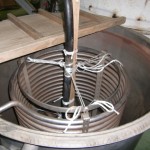 The true reason behind their call, driven though it was by the unbridled exuberance of the “kaizou” party, was to thank me for a positive assessment of a new sake they came out with that I was fortunate enough to have been able to taste several days earlier. I had recently ran into the two of them by coincidence, armed with a bottle, at a sake pub the night before a big Tokyo tasting. Regardless, it was great fun to hear from them, and congratulate them on completing the season.
The true reason behind their call, driven though it was by the unbridled exuberance of the “kaizou” party, was to thank me for a positive assessment of a new sake they came out with that I was fortunate enough to have been able to taste several days earlier. I had recently ran into the two of them by coincidence, armed with a bottle, at a sake pub the night before a big Tokyo tasting. Regardless, it was great fun to hear from them, and congratulate them on completing the season.
“Hold on. There is someone here that wants to talk to you.” The cell phone got dropped at least twice and bashed into something made of glass on its way to whomever it was destined. Things like that happen in a room full of happy, buzzed sake brewers. Actually, I knew who it was going to be before I even heard the familiar voice.
“Du-hu-hu-hu-de. I’m pretty hammered too-hu-hu-hu.” It was the relatively young toji (master brewer) at that kura. “We made it through yet another season. And thanks to your support, we finished without a hitch…”
It was fun to hear from them, late though it might have been, and they certainly deserved to celebrate.
As many readers certainly recall, sake brewing runs roughly from the fall until the spring. Just when a kura begins to brew sake and when they finish for the year depends on a number of factors, including of course how much they brew. On top of this, dynamics including the number of brewers, number of tanks, size of the batches, how old or new their equipment is, and how often they fire up a new batch will all combine to determine just when they start and end. But typically it runs from mid-October to mid-April.
As the season draws to a close, there are two significant days that the people in the brewery owners and brewers together will celebrate. One is called “koshiki-taoshi,” the other is “kaizou.”
“Koshiki-taoshi” means “overturning the rice steaming vat.” A koshiki is the large vat in which rice is steamed every morning or so. In days of olde, the koshiki was made of wood (sugi, i.e. cryptomeria) and sat on top of a large iron cauldron of water (called a wagama) that tapers at the top.
Today only a handful of kura use wooden koshiki anymore. The craftsmen to make them are also all but gone. Most are steel these days, and in fact, many are fully automatic. Long ago, when the last vat of rice had been steamed, the koshiki would be turned over onto its side, cleaned thoroughly, and left to dry and be put into storage until next season. This is the term to which koshiki-taoshi refers.
When the last batch of rice has been steamed for the year, the brewers can see the light at the end of the brewing-season’s tunnel, hence the celebratory nature of the day.
Of course, that last day’s vat of rice will then be added to the last tank still fermenting, and after that there is still three weeks or more of waiting for those last few batches to finish fermenting, and then be pressed and sent to mature for a while. So their work is far from done. Koshiki-taoshi means only that there is no more rice to be steamed. Within two days, there will be no more koji to be made, and soon after that it is simply a matter of waiting. They know they are getting close to the end of six months or more of long, hard days.
Often in these modern times, automated koshiki are equipped in such a way that they can  be turned sideways to make it easier to scoop out the rice. Kinda makes knocking them over a bit anticlimactic. Also, large brewers have continuous rice steamers, large contraptions that steam rice as it moves along on a mesh conveyor belt over steam, and constantly crank it out. So at such places there is no koshiki to knock over. But nonetheless, a ceremony and small party are held to acknowledge the significance of the last steaming of the season.
be turned sideways to make it easier to scoop out the rice. Kinda makes knocking them over a bit anticlimactic. Also, large brewers have continuous rice steamers, large contraptions that steam rice as it moves along on a mesh conveyor belt over steam, and constantly crank it out. So at such places there is no koshiki to knock over. But nonetheless, a ceremony and small party are held to acknowledge the significance of the last steaming of the season.
The next milestone is “kaizo.” “Kaizo” is written with characters that mean “all (has been) made,” and naturally enough indicates the day on which the last tank has been pressed, and therefore all the sake for the year has been brewed. All there is left to do is to sweep up, tidy up, and pack up.
After one or the other – or perhaps even both – of these significant days, the brewers and other employees of a sake brewery will often have a little bash in the kura. The kuramoto (brewery owner) will prepare a nice dinner, there will be warm toasts to each other, and there will be plenty of sake consumed. Also, newly made sake is offered to the gods in thanks for the blessings of the brewing season.
While, from what I have heard, it is more common to have this little party after koshiki-taoshi, obviously the folks at some places (like my friend in the intro) wait until kaizo, when presumably they can sleep late the next day.
Back in the 1960s when several of the larger kura rode continued growth to mammoth-hood, they began to brew all year round, in what is called “shiki-jozo,” or “four-season brewing.” However, as sake consumption has dropped off, especially that of cheap sake, the need for year-round brewing has dropped off, and none of the big brewers are doing this any longer.
But interestingly, there are a handful of smaller brewers that brew basically all 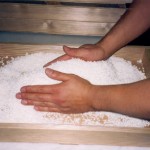 year, freezing the rice for use in the summer, and brewing at a more manageable, mellow pace. This pace might be starting a batch once or twice a week rather than everey day. Just when these places celebrate koshiki-taoshi is not clear. But I am sure they work it in somewhere!
year, freezing the rice for use in the summer, and brewing at a more manageable, mellow pace. This pace might be starting a batch once or twice a week rather than everey day. Just when these places celebrate koshiki-taoshi is not clear. But I am sure they work it in somewhere!
~~~~~~~~~~~~~~~~~~~~~~~~~~~~~~~~~~~~~~~~~~~~~~~~~~~~~~~~~~~~~
Be sure to look for my new book, Sake Confidential, due out in June. You can reserve your copy now at Amazon!
In over two-dozen short essays presented in a very informal and conversational tone, “the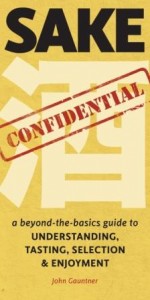 truth about sake” is revealed. The truth about junmai types versus non-junmai types, the truth about the impossibly detailed craft of sake brewing, the truth about temperature, premium types, aging, purity, pasteurization and regionality are all touched upon.
truth about sake” is revealed. The truth about junmai types versus non-junmai types, the truth about the impossibly detailed craft of sake brewing, the truth about temperature, premium types, aging, purity, pasteurization and regionality are all touched upon.
How the industry works, its challenges and strengths, what really creates sake flavors and aromas, specs you can safely ignore, and what hype you can safely avoid are all fair game. You’ll learn what goes into sake pricing, and how brewers get their rice. How to choose sake, and how to improve your tasting ability are also part of the fun. Suffice it to say that nowhere else is so much detailed information about the realities of the sake world assembled together into one place.
– See more at: http://sake-world.com/#sthash.5LOAMrBD.dpuf
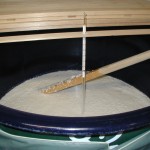 brewed quite like sake is. Perhaps the most obvious difference is that the ingredients are added in stages. The first two to four weeks see the creation of a yeast starter, to secure a high population of yeast cells, and after that, the rest of the ingredients are added, again, in stages.
brewed quite like sake is. Perhaps the most obvious difference is that the ingredients are added in stages. The first two to four weeks see the creation of a yeast starter, to secure a high population of yeast cells, and after that, the rest of the ingredients are added, again, in stages.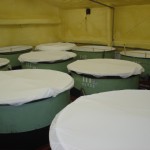 koji are added to roughly double the size of the batch. After letting that sit two days, the size of the batch is again doubled. And, one day later, more ingredients are added to again double the existing size of the batch. So in the end, the yeast starter is about an eighth or so of the final size of the batch. (This will of course vary a bit from place to place.)
koji are added to roughly double the size of the batch. After letting that sit two days, the size of the batch is again doubled. And, one day later, more ingredients are added to again double the existing size of the batch. So in the end, the yeast starter is about an eighth or so of the final size of the batch. (This will of course vary a bit from place to place.)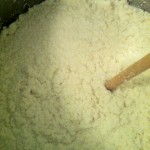 And it is what it sounds like: no yeast starter is used; instead, a comparatively huge amount of pure yeast is added to the batch right away, allowing it to ferment a full tank right off the bat. In truth, very little sake is made this way, and it is usually cheaper sake made in huge batches. It is a perfectly valid way to make sake, and the resulting sake is often quite good.
And it is what it sounds like: no yeast starter is used; instead, a comparatively huge amount of pure yeast is added to the batch right away, allowing it to ferment a full tank right off the bat. In truth, very little sake is made this way, and it is usually cheaper sake made in huge batches. It is a perfectly valid way to make sake, and the resulting sake is often quite good.




